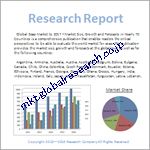目次
第1章.マスフローコントローラーの世界市場エグゼクティブサマリー
1.1.マスフローコントローラーの世界市場規模・予測(2022年~2032年)
1.2.地域別概要
1.3.セグメント別概要
1.3.1.タイプ別
1.3.2.フローエレメント別
1.3.3.流量別
1.3.4.エンドユーザー別
1.4.主要動向
1.5.景気後退の影響
1.6.アナリストの提言と結論
第2章.マスフローコントローラの世界市場の定義と調査前提
2.1.調査目的
2.2.市場の定義
2.3.調査の前提
2.3.1.包含と除外
2.3.2.限界
2.3.3.サプライサイド分析
2.3.3.1.入手可能性
2.3.3.2.インフラ
2.3.3.3.規制環境
2.3.3.4.市場競争
2.3.3.5.経済性(消費者の視点)
2.3.4.需要サイド分析
2.3.4.1.規制の枠組み
2.3.4.2.技術の進歩
2.3.4.3.環境への配慮
2.3.4.4.消費者の意識と受容
2.4.推定方法
2.5.調査対象年
2.6.通貨換算レート
第3章.マスフローコントローラーの世界市場ダイナミクス
3.1.市場促進要因
3.1.1.産業オートメーション化の進展
3.1.2.半導体とライフサイエンスにおける精密さへの要求の高まり
3.1.3.流量制御技術の進歩
3.2.市場の課題
3.2.1.導入時のイニシャルコストの高さ
3.2.2.多様なエンドユーザー間でのMFC統合の複雑さ
3.3.市場機会
3.3.1.インダストリー4.0エコシステムにおけるアプリケーションの拡大
3.3.2.新興経済圏における機会
第4章.マスフローコントローラーの世界市場産業分析
4.1.ポーターのファイブフォースモデル
4.1.1.サプライヤーの交渉力
4.1.2.バイヤーの交渉力
4.1.3.新規参入者の脅威
4.1.4.代替品の脅威
4.1.5.競合他社との競争
4.2.PESTEL分析
4.2.1.政治的
4.2.2.経済的
4.2.3.社会的
4.2.4.技術的
4.2.5.環境
4.2.6.法律
4.3.主な投資機会
4.4.勝つための戦略
4.5.アナリストの推奨と結論
第5章.マスフローコントローラーの世界市場規模・タイプ別予測(2022年~2032年)
5.1.セグメントダッシュボード
5.2.市場規模・予測(2022年~2032年)
5.2.1.サーマルマスフローコントローラー
5.2.2.コリオリ式マスフローコントローラ
5.2.3.差圧マスフローコントローラ
第6章.フローエレメント別マスフローコントローラの世界市場規模・予測(2022年~2032年)
6.1.セグメントダッシュボード
6.2.市場規模・予測(2022年~2032年)
6.2.1.ガス
6.2.2.液体
第7章.マスフローコントローラーの世界市場規模・予測(流量別)(2022年~2032年
7.1.セグメントダッシュボード
7.2.市場規模・予測(2022年~2032年)
7.2.1.ローフロー
7.2.2.中流
7.2.3.高流量
第8章.マスフローコントローラーの世界市場規模・エンドユーザー別予測(2022年~2032年)
8.1.セグメントダッシュボード
8.2.市場規模・予測(2022年~2032年)
8.2.1.石油・ガス
8.2.2.半導体
8.2.3.ライフサイエンス
8.2.4.化学
8.2.5.上下水道
8.2.6.食品・飲料
8.2.7.その他
第9章.マスフローコントローラーの世界市場規模・地域別予測(2022年〜2032年)
9.1.北米マスフローコントローラー市場
9.1.1.米国
9.1.2.カナダ
9.2.欧州マスフローコントローラー市場
9.2.1.英国
9.2.2.ドイツ
9.2.3.イタリア
9.2.4.フランス
9.2.5.その他のヨーロッパ
9.3.アジア太平洋マスフローコントローラー市場
9.3.1.中国
9.3.2.インド
9.3.3.日本
9.3.4.韓国
9.3.5.オーストラリア
9.3.6.その他のアジア太平洋地域
9.4.ラテンアメリカのマスフローコントローラー市場
9.4.1.ブラジル
9.4.2.メキシコ
9.4.3.アルゼンチン
9.4.4.その他のラテンアメリカ
9.5.中東・アフリカのマスフローコントローラー市場
9.5.1.アラブ首長国連邦
9.5.2.サウジアラビア
9.5.3.南アフリカ
9.5.4.その他の中東・アフリカ
第10章 競争力コンペティティブ・インテリジェンス
10.1.主要企業のSWOT分析
10.1.1.ブルックス・インストゥルメント
10.1.2.MKSインスツルメンツ
10.1.3.ブロンコスト・ハイテックB.V.
10.2.トップ市場戦略
10.3.企業プロフィール
10.3.1.ブルックス・インストゥルメント
10.3.2.MKSインスツルメンツ
10.3.3.ブロンコスト・ハイテックB.V.
10.3.4.シエラ・インスツルメンツ
10.3.5.アリカット・サイエンティフィック
10.3.6.堀場ステック
10.3.7.センシリオンAG
10.3.8.Aalborg Instruments & Controls, Inc.
10.3.9.東京計装株式会社
10.3.10.サーマル・インストルメント・カンパニー
第11章.研究プロセス
11.1.研究プロセス
11.1.1.データマイニング
11.1.2.分析
11.1.3.市場推定
11.1.4.バリデーション
11.1.5.出版
11.2.研究属性
表一覧
1.マスフローコントローラの世界市場:地域別、2022年~2032年(百万米ドル)
2.北米市場シェア分析、国別
3.ヨーロッパ市場シェア分析、国別
(リストはすべての表で同様のセグメンテーションで続きます)
図表一覧
1.マスフローコントローラの世界市場、歴史的収益、202-20232年(USD Million)
2.マスフローコントローラー市場のポーターズファイブフォース分析
3.タイプ別世界市場シェア(サーマル、コリオリなど)
(コンテンツに沿った図表を追加してリストは続きます)
Mass flow controllers (MFCs) are highly accurate instruments engineered to measure and control gas or liquid flow rates in various industrial processes. Their precise and consistent flow measurement is critical for applications in sectors such as semiconductor manufacturing, life sciences, and water treatment systems. The global demand for these devices is propelled by Industry 4.0 adoption, which emphasizes automation and efficiency across production processes.
The growing emphasis on environmental monitoring, coupled with investments in advanced R&D for smart manufacturing and digital transformation, has created new opportunities for MFC technologies. For instance, industries like pharmaceuticals and biotechnology require highly controlled environments, fueling the need for accurate gas and liquid flow controllers to optimize production.
The thermal mass flow controller segment accounted for the largest market share in 2023, thanks to its superior adaptability and accuracy across applications such as semiconductors, biotechnology, and chemical processing. Furthermore, the gas flow element segment dominates in terms of revenue, driven by its application in environmental monitoring systems, semiconductor manufacturing, and industrial burner controls.
The low-flow segment, which caters to gas chromatography and spectroscopy applications, is projected to grow at the highest CAGR. Meanwhile, the semiconductor industry remains the largest end-user segment, leveraging MFCs for deposition, etching, and thermal processing in advanced chip manufacturing.
Regionally, North America led the market in 2023 due to its strong base of semiconductor manufacturers and biotechnology firms. However, the Asia Pacific is poised to grow at the fastest rate, driven by increasing healthcare demand and government initiatives in high-tech manufacturing. Countries like China, India, and Japan are witnessing rapid adoption of MFC technologies in applications spanning pharmaceuticals, water treatment, and electronics.
Major market players included in this report are:
1. Brooks Instrument
2. MKS Instruments
3. Bronkhorst High-Tech B.V.
4. Sierra Instruments
5. Alicat Scientific
6. HORIBA STEC
7. Sensirion AG
8. Aalborg Instruments & Controls, Inc.
9. Tokyo Keiso Co., Ltd.
10. Thermal Instrument Company
11. Omega Engineering
12. Teledyne Tekmar
13. Sensyflow
14. Teledyne Hastings Instruments
15. Nafion
The detailed segments and sub-segments of the market are explained below:
By Type:
• Thermal Mass Flow Controller
• Coriolis Mass Flow Controller
• Differential Pressure Mass Flow Controller
By Flow Element:
• Gas
• Liquid
By Flow Rate:
• Low Flow
• Medium Flow
• High Flow
By End-User:
• Oil & Gas
• Semiconductor
• Life Sciences
• Chemical
• Water & Wastewater
• Food & Beverage
• Others
By Region:
North America: U.S., Canada
Europe: UK, Germany, Italy, France
Asia Pacific: China, India, Japan, South Korea, Australia
Latin America: Brazil, Mexico, Argentina
Middle East & Africa: UAE, Saudi Arabia, South Africa
Years considered for the study are as follows:
Historical Year: 2022
Base Year: 2023
Forecast Period: 2024–2032
Key Takeaways:
• Market Estimates & Forecast for 10 years from 2022 to 2032
• Annualized revenues and regional-level analysis for each market segment
• Competitive landscape analysis with company profiles of key players
• Analysis of demand-side and supply-side factors influencing the market
• Detailed segmentation covering all major types, applications, and regions
❖ 免責事項 ❖
http://www.globalresearch.jp/disclaimer

